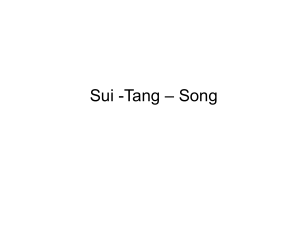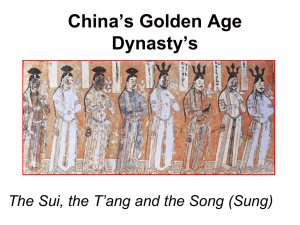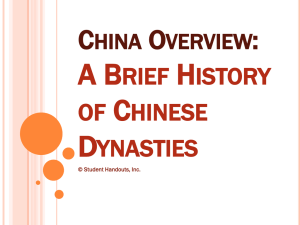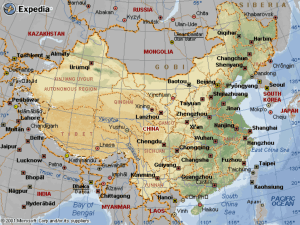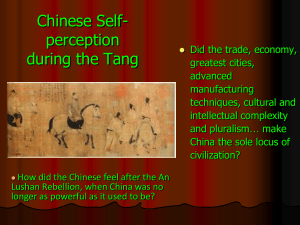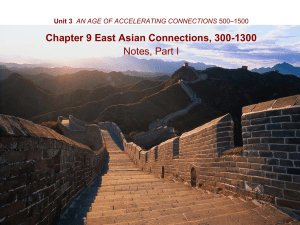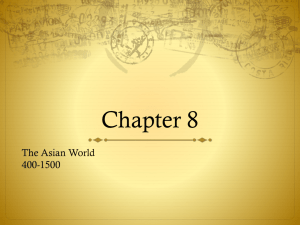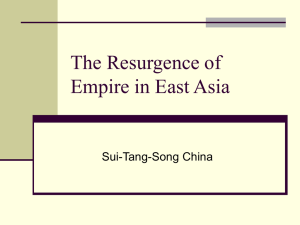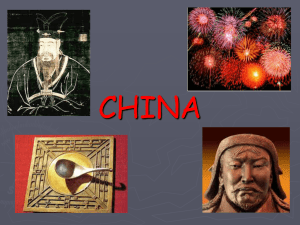Nina History
advertisement
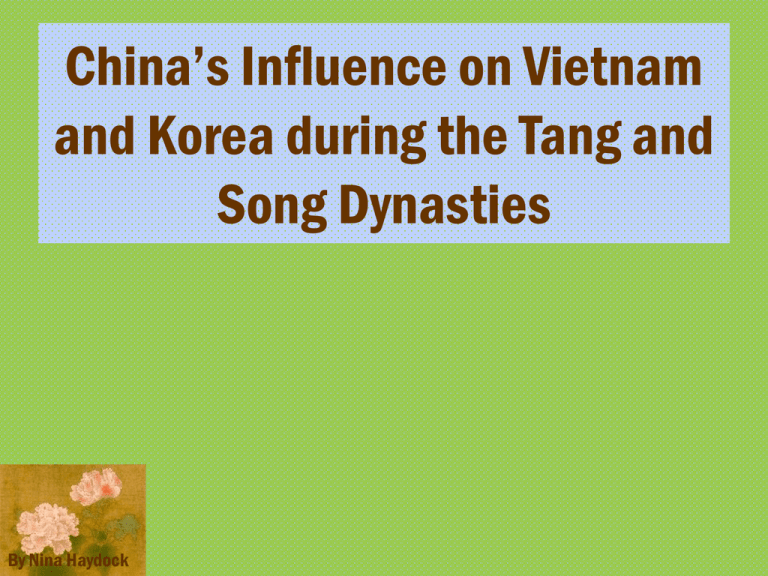
China’s Influence on Vietnam and Korea during the Tang and Song Dynasties By Nina Haydock Tang Dynasty 618-907CE Following the assassination of Sui Yangdi The Sui Dynasty came to an end in 618CE A rebel leader, Li Yuan, captured Chang’an Proclaimed himself emperor, named the Dynasty Tang Li Yuan’s reign ended in 626CE Taizong (627-649CE), second emperor of the Tang Dynasty Murdered two brothers and forced the abdication of his father to be emperor One of the greatest emperors in Chinese History His reign is referred to as “Flourishing Age” Tang Taizong Tang Dynasty • Tang Code (624CE), first set of Chinese Codes. Consists of Crimes and their penalties. • Refined distribution of land. Equal distribution of land to peasant families. Allowed all enough land to support themselves and pay taxes. • Increase production of rice as it became more profitable. Developed new tools to cultivate rice. Rice Field Plow • Armies consisted of aristocrats and peasants. The army had 700,000 horses which were used by accomplished cavalrymen. • Buddhism was at it’s peak in the beginning of the Tang Dynasty. Confucianism slowly gained a greater following. In 845CE, Emperor Li Chan forbid Buddhism. 40,000 temples and shrines were destroyed. Song Dynasty • Divided into the Northern Song Dynasty and the Southern Song Dynasty Northern Dynasty (960-1126CE) Southern Dynasty (1127-1289CE) Northern Song Dynasty Capital- Kaifeng Before Song Dynasty lost control of northern China to the Jurchen Jin Dynasty, they occupied territory to the north of the Yangzi River. Yangzi River Southern Song Dynasty Capital- Hangzhou Dynasty controlled most of inner China Song Government and Advances • Taizu (960-1279CE), first emperor of the Song Dynasty. Proclaimed emperor by his troops. Emperor Taizu • Developed a strong central government, all military and government officials were favored and paid handsomely. • Developed the use of gunpowder, the cannon and the flamethrower. An accurate clock was made in the city of Kaifeng. • Advances in printing allowed books to become more common to the wealthy. Education increased (to become part of the government examinations were developed) • Neo-Confucianism spread during the dynasty. Zhu Xi helped in this expansion. Nobles lived up to Confucian ideals, selflessness. • The well-known blue and white porcelain became popular. Celadon, another type of porcelain became popular. Celadon porcelain Chinese Invasion of Korea During the Tang Dynasty, Chinese invaded Korea in hopes of expanding the empire. The leader of the Silla Dynasty recognized defeat. The Silla Emperor agreed to recognize the Tang Emperor as it’s superior. New Capital was built at Kumsong – resembling the Tang capital at Chang’an Confucianism spread throughout the elite in Korea. The Chinese system of schooling also became popular in Korea. Invasion of Vietnam Overpowered resistance from the Viets, expanded Chinese culture and ways of living Spread education throughout Vietnam Even though the Chinese could not overpower the Vietnamese in the south. The Chinese culture had influence there as well. The southern Vietnamese’s government reflected aspects of the Chinese government. Confucianism also played a part in the education of government officials. Sources 1. 2. 3. 4. 5. 6. 7. 8. http://www.britannica.com/eb/article-9071162/Tang-Dynasty http://www.mnsu.edu/emuseum/prehistory/china/classical_imperial_china/tang. html http://library.thinkquest.org/12255/library/dynasty/tang.html http://www.allempires.com/article/index.php?q=The_Song_Dynasty http://www.hometownchina.com/song.htm http://www.mnsu.edu/emuseum/prehistory/china/classical_imperial_china/song .html http://en.wikipedia.org/wiki/Song_Dynasty http://www.geocities.com/CollegePark/Union/7050/tang.htm

